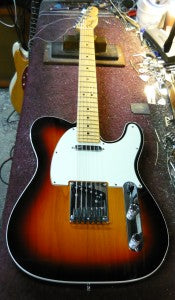Fender Tele with a Brierley pickup
Share
Most of you who read my blog know I'ma huge fan of these pick ups. Mick, while being just one of the many aftermarket, hand made pick ups on the market makes what I consider to be the best I've heard, and I've heard a few.
This was a pretty standard US made Fender Telecatser deluxe series. Bound contoured body and neck joint. Maple neck and noiseless pick ups.
I'm not usually a huge fan of binding but I don't mind binding on the Tele body. The plainness of the Tele body looks quite good with binding, especially in sunburst.
The neck is quite thick and modern feeling with a compound radius fretboard and medium large frets. This model also has the "S-1" switching system which I find a little, unnecessary on a Tele. I don't think you buy a Tele to get a multitude of tones. You buy one to get a Tele tone.
You have to take the neck off to get the scratchplate off on these as the extra fret hangs over the end of the neck and over the scratchplate. The plate won't move backwards as the pickup cavities stop it.
This model (like most US and Mexican) is routed for all the pick up combinations that Fender offer. This means it's cheaper for them to make bodies as "one fits all", or most.
This model also has the neck tilt mechanism as designed by Leo in the late sixties and badly executed by Fender after Leo left. It's a great idea when done properly.
With the body already routed it was just a matter of cutting the scratchplate to fit a humbucker and reassemble.
This is one of Micks PAF style humbuckers which are always a treat to fit and hear in different guitars. This one was no exception. The pickups balanced out really nicely with minimal height adjustments and the guitar sounds great in all three positions.
The nut needed a little work for the set up as it was still standard factory height (ie: too high) and the truss rod needed a small tweak but it all came together really well. The action was low in the middle which is common on factory set up Fenders (and Gibsons, but that's because Gibson can't radius a tune-o-matic to suit the fretboard radius). The six saddle bridge always helps with intonating Teles although personally, I still think the three saddle (brass or steel) sounds better, but that's just personal, and of course, is a compromise when it comes to playing in tune.













